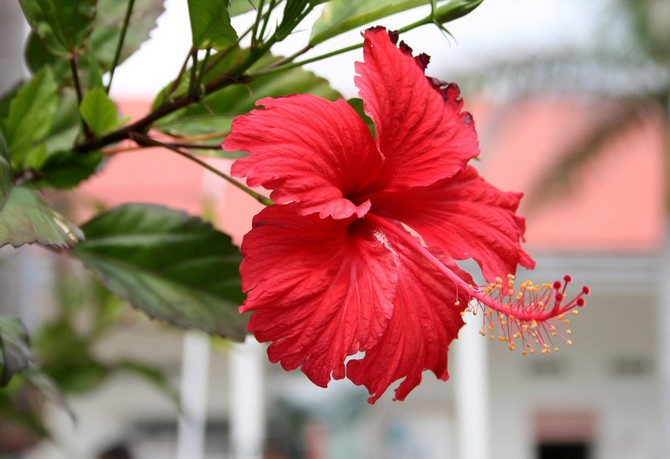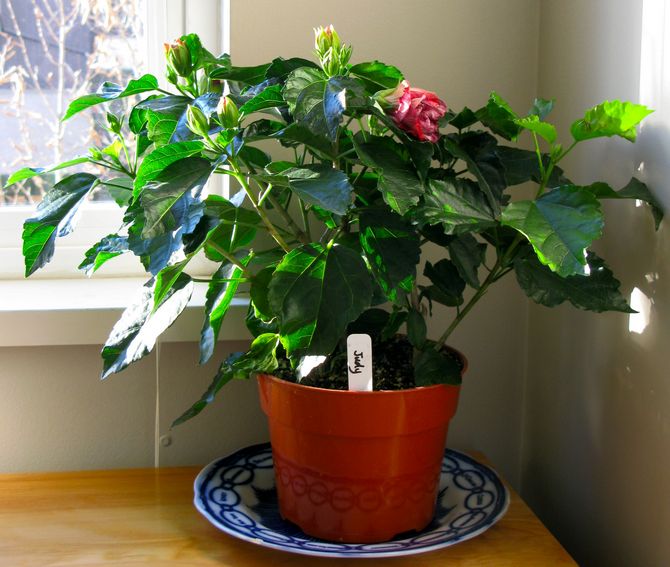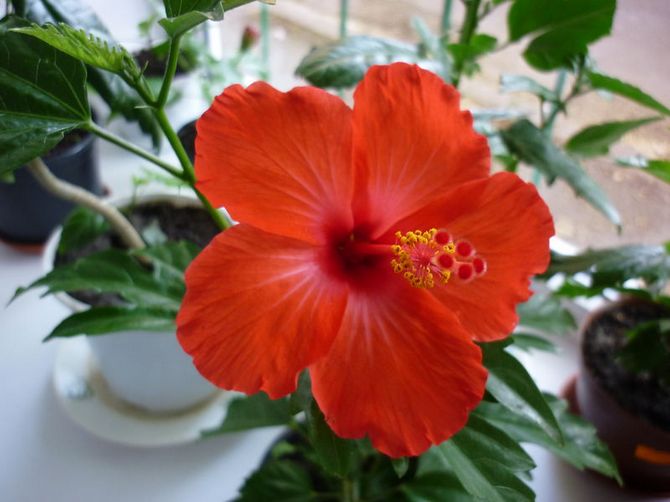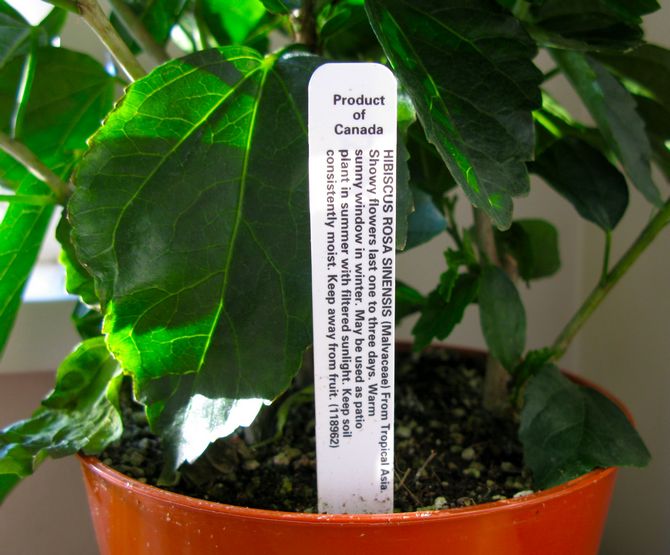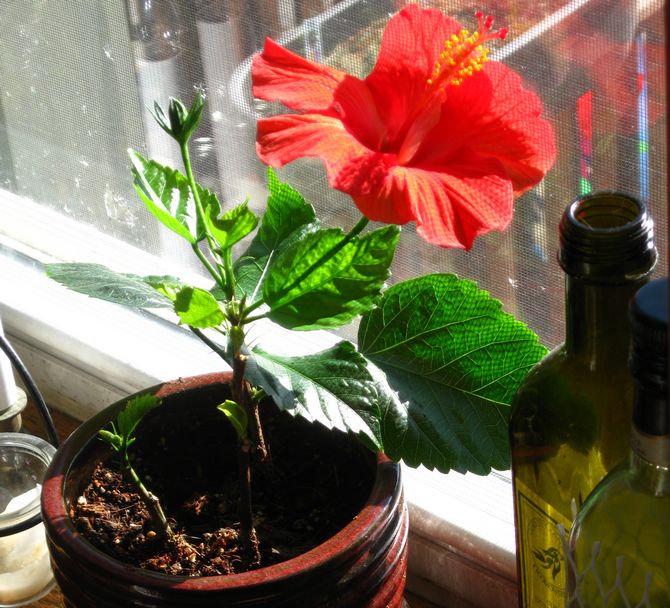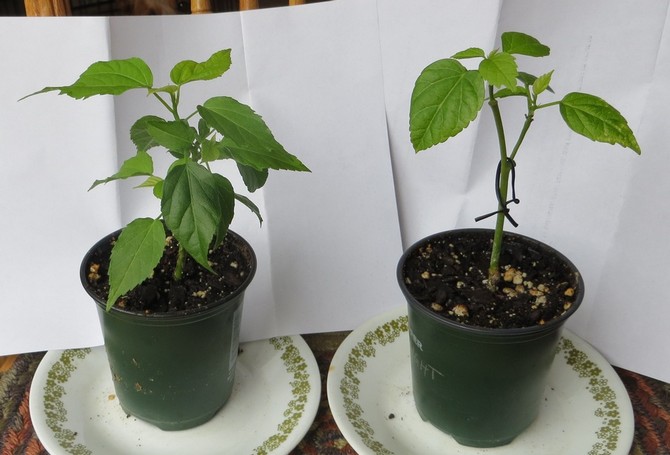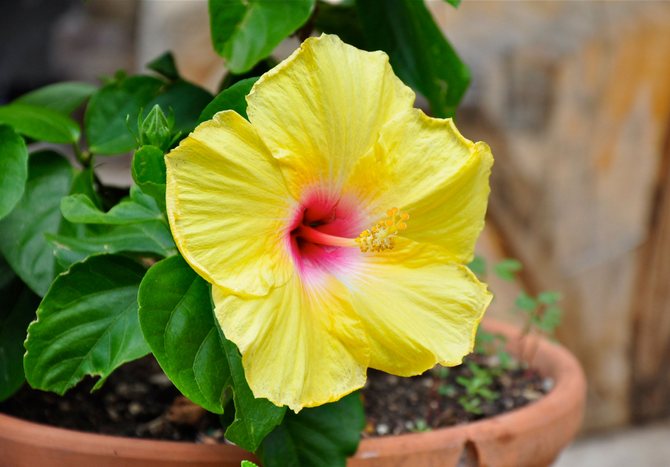For someone who wants to have a beautiful plant at home, but still does not know how to take care of indoor flowers, hibiscus is ideal. Despite its beauty, this plant is very unpretentious. It can easily withstand low light, and sudden temperature changes, and insidious drafts. It will not be lost even if you miss watering time. It is thanks to this unpretentiousness of it that hibiscus is often placed in offices, living rooms, in the halls and corridors of various institutions..
Hibiscus is called the “Chinese rose”, and this name conveys the beauty of this plant as accurately as possible. However, in order for hibiscus not only to live, but also to delight you with its bright flowering, you need to remember a few tips.
Caring for indoor hibiscus at home
Location and lighting
The first thing that a beginner grower needs to learn is a light-loving hibiscus plant. Place it by a window or any other well-lit place. Also do not forget that hibiscus grows very quickly and grows quite large. In a small room, there may be problems with its placement: this flower does not like crampedness. The pot in which the hibiscus will live also plays an important role: the tighter the pot, the slower it will grow..
Temperature
The optimum temperature for a Chinese rose in the summer is 20-22 degrees. In winter, the temperature should be lowered to 14-16 degrees. Lowering the temperature in winter will have a positive effect on the future flowering of hibiscus. If you do not have the opportunity to keep the flower in low temperature conditions, do not be discouraged – the Chinese rose can grow in winter and at room temperature..
Air humidity
Hibiscus needs frequent spraying, as the flower loves high humidity. If you keep hibiscus in a room with dry air, then there is a high probability that the flowers will not be able to fully open. Spraying should be carried out as carefully as possible – water should not get on the flowers, otherwise the buds will be covered with spots and fall off.
To increase the humidity, you can use a pallet with expanded clay or pebbles filled with water. But remember, the bottom of the pot must not touch the water.!
Watering
Hibiscus loves moisture. Water it abundantly so that the soil in the pot is completely saturated with water. But it is not worth watering the Chinese rose too often – the top layer of the earth should have time to dry out. In autumn and winter, watering should be moderate, after about 2-3 days, half after the top layer dries out. For watering it is better to use constant soft water at room temperature..
The soil
The soil for growing hibiscus should be nutritious and light, it should be close to neutral (pH about 6). The ideal soil composition would be a mixture of sod, leafy, humus soil and sand in a ratio of 4: 3: 1: 1. Pieces of charcoal can be added to the composition of the earth. A simplified soil composition is also suitable: turf, humus soil and sand in proportions of 2: 1: 1.
Do not forget to take care of good drainage, the flower does not tolerate stagnant water in a pot!
Top dressing and fertilizers
Top dressing plays an important role in the care of indoor hibiscus. It is very important not to overdo it with fertilizers. In the spring, when the hibiscus is preparing to start growing, it is worth feeding it with potassium-phosphorus fertilizer. For the rest of the fertilizers, the optimal time will be summer, when the flower grows most actively. But it is better to refuse nitrogen-containing fertilizers – hibiscus does not like them too much.
Transfer
Young plants need to be replanted every year. To do this, mix in a pre-prepared pot or tub 2 parts of garden soil, 1 part of sand and 1 part of peat. If you are replanting a large plant, then the mixture should be prepared heavier..
From the age of three, the need for an annual transplant disappears: an adult plant must be transplanted every 2-3 years.
Pruning
There is a categorical answer to this question – yes, we do! Formative pruning must be done annually, only under this condition will the Chinese rose delight you with its flowering. Each time after flowering, the tips of the shoots must be pruned, then the lateral shoots will grow, on which, in turn, buds will form. Keep in mind that hibiscus flowers only appear on young shoots, so each shoot that is not cut in time is another flower that you will miss next year..
In early spring, it is very useful to pinch all the shoots – including the young ones. Although pruning indoor hibiscus can be carried out throughout the year, it does not harm it at all..
Shoots that grow parallel to the main trunk (they are called “tops”) must be cut off. Just like those of the branches that grow inside the crown. Don’t worry about the flower, regular pruning is good for it, ensuring healthy growth and abundant flowering..
Reproduction of indoor hibiscus
Indoor hibiscus propagates both by seeds and cuttings. However, there is too much trouble with seeds for a novice grower – this method is quite laborious and is more suitable for those who are engaged in the selection of indoor hibiscus. And propagation by cuttings has several indisputable advantages. Firstly, this method retains all the varietal characteristics inherent in the parent plant. And secondly (which is especially important for an amateur grower), with this method, the plant begins to bloom in the first year.
Seed propagation
Seeds are best sown from late January to mid-March. Before planting seeds in the ground, they should be soaked for 12 hours in Epin. You need to plant seeds in a mixture of peat and sand. After planting, the pot is covered with glass or foil to create greenhouse conditions. It is necessary to constantly maintain the temperature within 25-27 degrees. Also, do not forget to periodically air the pot and spray the soil with seeds..
When young sprouts have 2-3 leaves, they can be transplanted into a separate pot. Hibiscus grown from seed will only flower for 2-3 years.
Propagation by cuttings
Young cuttings are best suited for propagation. Place them in water or soil to root. In the first case, you will need a vessel, preferably made of dark glass, filled with water. Place a stalk in it and cover with a “cap” – for example, a glass jar. This is necessary to increase humidity. Cuttings will take root in about 25-30 days. When the roots appear, the cutting will need to be transplanted into an earthen mixture containing a large amount of peat. It is advisable to add sphagnum moss there – this is especially useful for a young plant.
When rooting directly into the soil, you need a mixture of coarse sand and peat. But do not forget that before this, it is necessary to remove all leaves from the cutting, except for the two upper ones..
Growing difficulties
- Buds appear, but do not open and soon fall off – insufficient watering; drying out of the soil; lack of nutrients in the soil; low room temperature.
- Lower leaves fall, new leaves grow yellow – increased content of calcium and chlorine in the soil; lack of iron and nitrogen; too dry indoor air; abundant watering with cold water; low temperature.
- Lack of flowers with too lush crown – an excess of fertilizers containing nitrogen; the flower does not have enough light, the temperature is too high in winter.
- Pinkish spots appear on the leaves – lack of light; excess fertilizer.
- Leaves shriveled and become lethargic – lack of moisture.
- Roots dry out – soil temperature too low.
- The leaves dry up – the air in the room is too dry; high temperature in winter.
Diseases and pests
The greatest danger to indoor hibiscus is the scale insect and spider mite. To get rid of these pests, you must first wash the leaves with soapy water, and then spray with actellik solution..

